Science Bob
- Experiments
- Science Fair Ideas
- Science Q&A
- Research Help
- Experiment Blog

more in Experiment Blog
Oobleck – the cornstarch and water experiment.
This may just be the easiest, messiest, and most fun science activity I know. It is a classic, and I have gotten several requests recently to post directions. You should know that if you try this activity and you are not smiling and messy with corn starch goo at the end, then you are definitely doing something wrong. Also keep in mind that this is not just about fun, there is some pretty amazing science going on here.
You will need:
- Cornstarch (a 16 oz. box is good for every 2-3 participants – but more is always better)
- Food coloring (we always say it’s optional, but it does make it more fun – don’t use too much or you could end up with colored hands…and clothes…and curtains)
- A large bowl
- A camera – you’re probably going to want to take pictures.
Everyone should roll up their sleeves and prepare for some gooey fun.
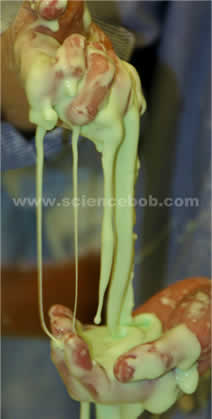
- This is easy. Pour the cornstarch into the bowl. Don’t rush to add water – take time to feel the cornstarch. Cornstarch does not feel like any other powder. It has a texture that can be compared to that of whipped cream. The grains of cornstarch are so small that they will fill into grooves of your fingerprints and make the prints stand out.
- After you’ve taken-in the feel of the powder, it is time to add water. (You should add the food coloring to your water before adding it to the powder.) There are no exact formulas regarding how much water to add, but it will end up being about 1/2 cup (120 ml) of water per cup (235 ml) of cornstarch. The secret is to add the water slowly and mix as you add it. Don’t be shy here – dig in with your hands and really mix it up. This is usually when you notice that this is not your average liquid. Add enough water so that the mixture slowly flows on its own when mixed. The best test is to reach in and grab a handful of the mixture and see if you can roll it into a ball between your hands – if you stop rolling it and it “melts” between your fingers – success!
We’ll get the the science soon, for now just dig in and explore. Notice that the goo does not splash (or even move) if you hit it quickly. Squeeze it hard and see what happens. How long can you get the strands of goo to drip? What happens if you let the goo sit on the table for a minute and then try to pick it up? How does it feel? Hows does it move? Try bouncing a ball on the surface of the cornstarch. You get the idea – explore!
30 minutes later…
So now goo is everywhere and you’re thinking you should probably start cleaning. Actual clean up of the goo is a snap. A bucket of warm water will quickly get it off your hands. It will brush off of clothes when it dries, and it is easily cleaned off surfaces with a wet rag.
Important : Make sure you do not dump the goo down the drain – it can get caught in the drain trap and take the joy out of your day of science. Dump it in the trash, or even mix it into soil in the garden.

Now for the science… Our cornstarch goo (sometimes referred to as “oobleck” from the Dr. Suess book) is what scientists call a “Non-Newtonian” liquid. Basically, Sir Issac Newton stated individual liquids flow at consistent, predictable rates. As you likely discovered, cornstarch goo does NOT follow those rules – it can act almost like a solid, and them flow like a liquid. Technically speaking, the goo is a SUSPENSION, meaning that the grains of starch are not dissolved, they are just suspended and spread out in the water. If you let the goo sit for an while, the cornstarch would settle to the bottom of the bowl.
So why does this concoction act the way it does? Most of it has to do with pressure. The size, shape, and makeup of the cornstarch grains causes the cornstarch to “lock-up” and hold its shape when pressure is applied to it. People have filled small pools with oobleck and they are able to walk across the surface of it (as long as they move quickly.) As soon as they stop walking, they begin to sink.
I hope you get to try this out. Let us know how your day with non-newtonian liquids went. Have fun exploring!

Science Experiments, Experiment Videos, and Science Fair Ideas from Science Bob
Ads (these ads support our free website), share this page.
May 2, 2011
It's a Solid... It's a Liquid... It's Oobleck!
Bring Science Home: Activity 1
By Katherine Harmon
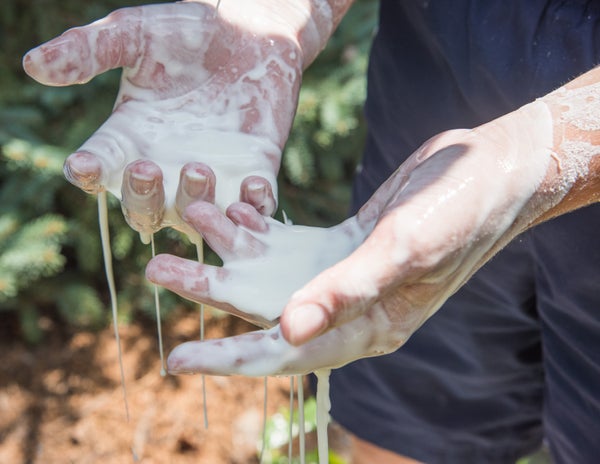
Getty Images
Key concepts Liquids and solids Viscosity Pressure From National Science Education Standards : Properties of objects and materials
Introduction Why is it so hard to get out of quicksand? Is it a solid? Is it a liquid? Can it be both? In this activity, you will make a substance that is similar to quicksand—but much more fun. Play around with it and find out how it acts differently from a normal liquid and a normal solid. Other, more familiar substances change states (from solids to liquids to gases) when we change the temperature, such as freezing water into ice or boiling it away into steam. But this simple mixture shows how changes in pressure, instead of temperature, can change the properties of some materials. Background Applying pressure to the mixture increases its viscosity (thickness). A quick tap on the surface of Oobleck will make it feel hard, because it forces the cornstarch particles together. But dip your hand slowly into the mix, and see what happens—your fingers slide in as easily as through water. Moving slowly gives the cornstarch particles time to move out of the way. Oobleck and other pressure-dependent substances (such as Silly Putty and quicksand) are not liquids such as water or oil. They are known as non-Newtonian fluids. This substance's funny name comes from a Dr. Seuss book called Bartholomew and the Oobleck .
On supporting science journalism
If you're enjoying this article, consider supporting our award-winning journalism by subscribing . By purchasing a subscription you are helping to ensure the future of impactful stories about the discoveries and ideas shaping our world today.
Materials • 1 cup of water • 1 to 2 cups of cornstarch • Mixing bowl • Food coloring (optional) Preparation • Pour one cup of cornstarch into the mixing bowl, and dip your hands into it. Can you feel how smooth the powder is? It's made up of super-fine particles. • Now pour the water in, mixing slowly as you go. Keep adding more water until the mixture becomes thick (and hardens when you tap on it). Add more cornstarch if it gets too runny, and more water if it becomes too thick. • Add a few drops of food coloring if desired. (If you want to turn your Oobleck another hue, it’s easier to add the coloring to the water before you mix it with the cornstarch.) • Oobleck is non-toxic, but please use caution when doing any science activity. Be careful not to get it in your eyes, and wash your hands after handling the Oobleck. Procedure • Roll up your sleeves and prepare to get messy! Drop your hands quickly into the Oobleck, then slowly lower your hands into it. Notice the difference! • Hold a handful in your open palm— what happens? • Try squeezing it in your fist or rolling it between your hands— how does it behave differently? • Move your fingers through the mixture slowly, then try moving them faster. • What else can you do to test the mixture's properties? • Extra: If you have a large plastic bin or tub, you can make a big batch of Oobleck. Multiply the quantity of each ingredient by 10 or more and mix it up. Take off your shoes and socks and try standing in the Oobleck! Can you walk across it without sinking in? Let you feet sink down and then try wiggling your toes. What happens?
Read on for observations, results and more resources.
Observations and results What is happening when you squeeze the Oobleck? What is happening when you release the pressure? Does the Oobleck remind you of anything else? The Oobleck mixture isn't your typical liquid—or solid. The cornstarch-and-water mixture creates a fluid that acts more like quicksand than water: applying force (squeezing or tapping it) causes it to become thicker. If you were trapped in a tub of Oobleck, what would be the best way to escape? Share your Oobleck observations and results! Leave a comment below or share your photos and feedback on Scientific American 's Facebook page . Cleanup Wash hands with water. Add plenty of extra water to the mixture before pouring it down the drain. Wipe up any dried cornstarch with a dry cloth before cleaning up any remaining residue with a damp sponge. More to explore " What is Jell-O? " from Scientific American " Ask the Experts: What Is Quicksand? " from Scientific American " States of Matter " overview from Idaho Public Television's Dialogue for Kids Slime and Goo activities from the American Chemical Society's Science for Kids Oobleck, Slime & Dancing Spaghetti: Twenty terrific at-home science experiments inspired by favorite children's books by Jennifer Williams, ages 4–8 The Everything Kids' Easy Science Experiments Book: Explore the world of science through quick and easy experiments! By J. Elizabeth Mills, ages 9–12 Up next… The Magic of Gravity What you'll need • Coin • Bottle, jar or canister with a small top opening (larger—but not too much bigger—than the coin) • 3- by-5-inch note card or other sturdy piece of paper • Scissors • Tape • Pen or pencil • Water (optional)
How to Mix Cornstarch and Water to Make Oobleck
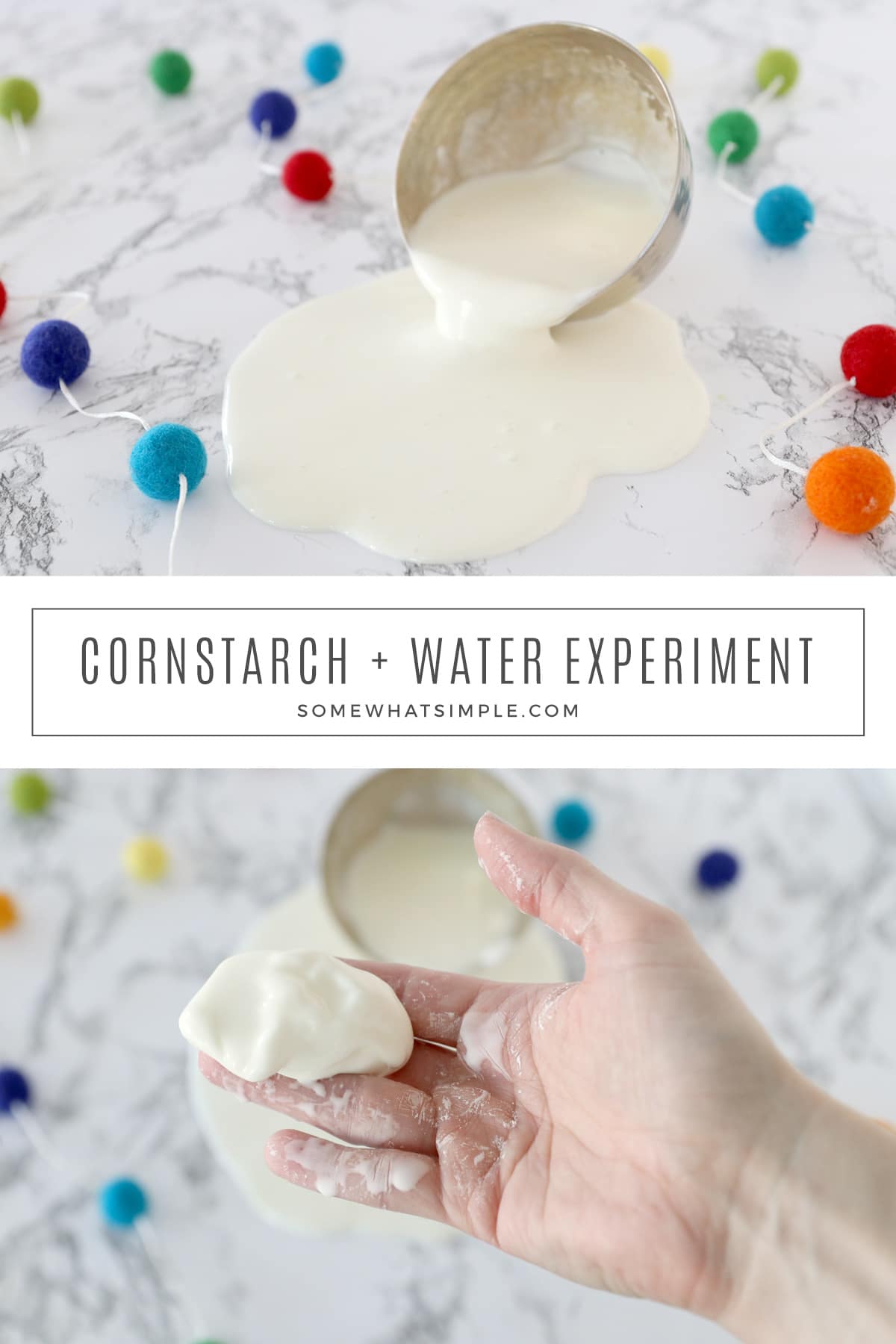
Pictured instructions and a video showing how to make and play with oobleck, a non-Newtonian fluid that flows like a liquid when moved slowly, but feels like a solid when you quickly push it.
For more science fun with the kids, be sure to check out our Edible Plant Cell project .
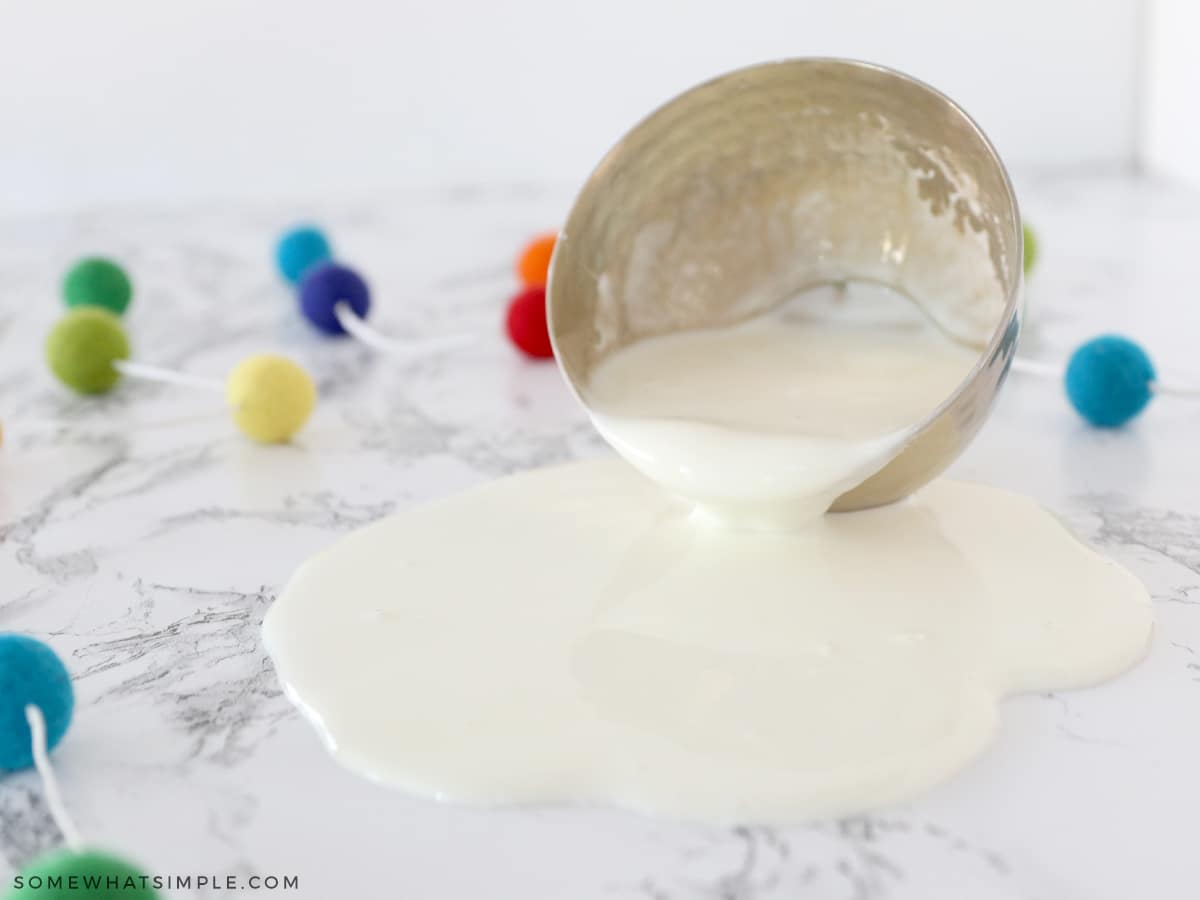
This cornstarch and water experiment is a great way to teach the States of Matter and non-Newtonian fluids. Is it a liquid or solid? YOU decide!
You can pick it up like a solid, but it will run through your fingers like a liquid – it is unlike anything you’ve felt before!
This experiment can be a bit messy, but couldn’t be easier to create and it will provide an entire afternoon of fun! Keep the kids at the counter and this Ooblek will wipe up just fine!
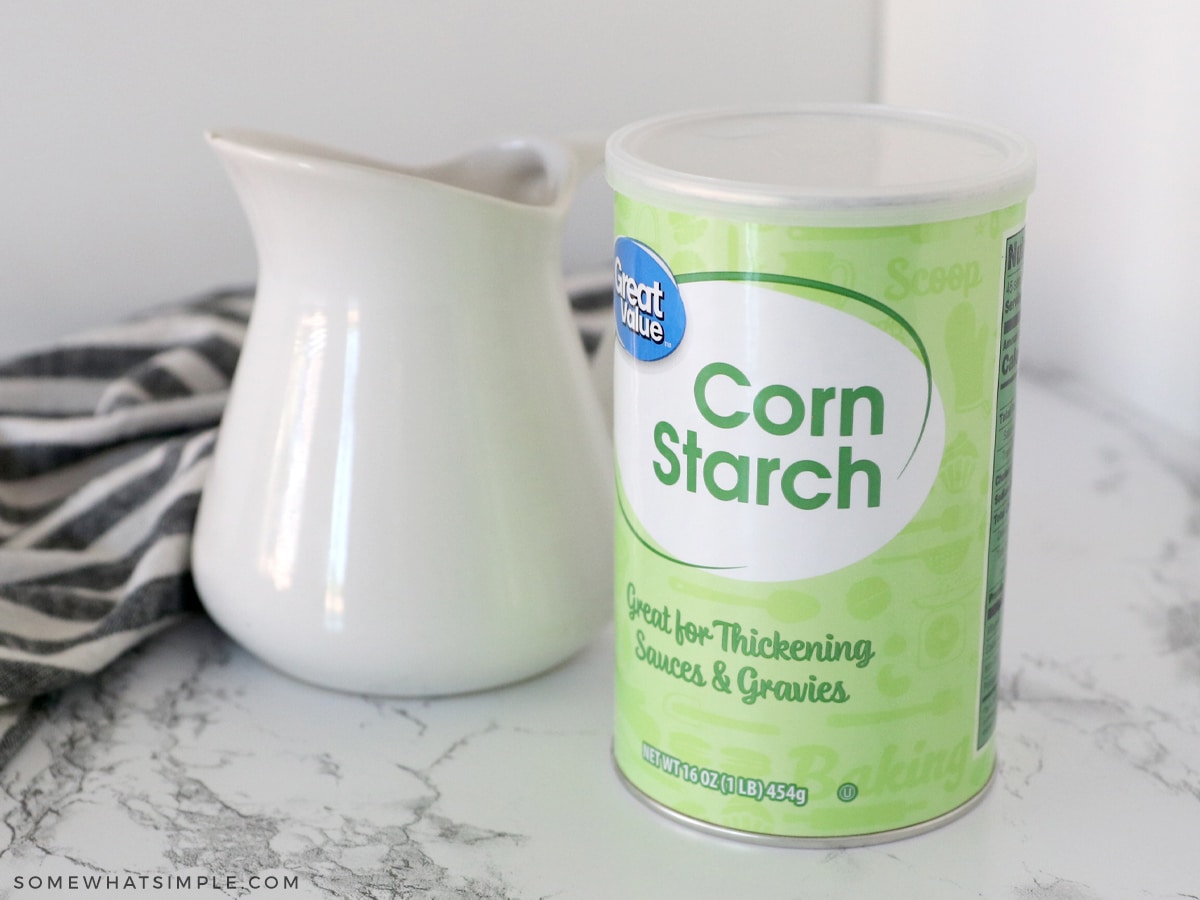
Cornstarch and Water Experiment
Here is the simple Oobleck recipe:
OOBLECK INGREDIENTS –
- 1 cup of corn starch
- 1/2 cup of water
- small dish or bowl
OPTIONAL MATERIALS –
- Newspaper (to cover your experiment area)
- Food Coloring (if you want to make it colorful)
- Small plastic toyS
CLASSROOM APPLICATIONS –
You can use this experiment in conjunction with the Dr. Suess’s book “Bartholomew and the Oobleck” . Just add some green food coloring to your mixture and have fun!
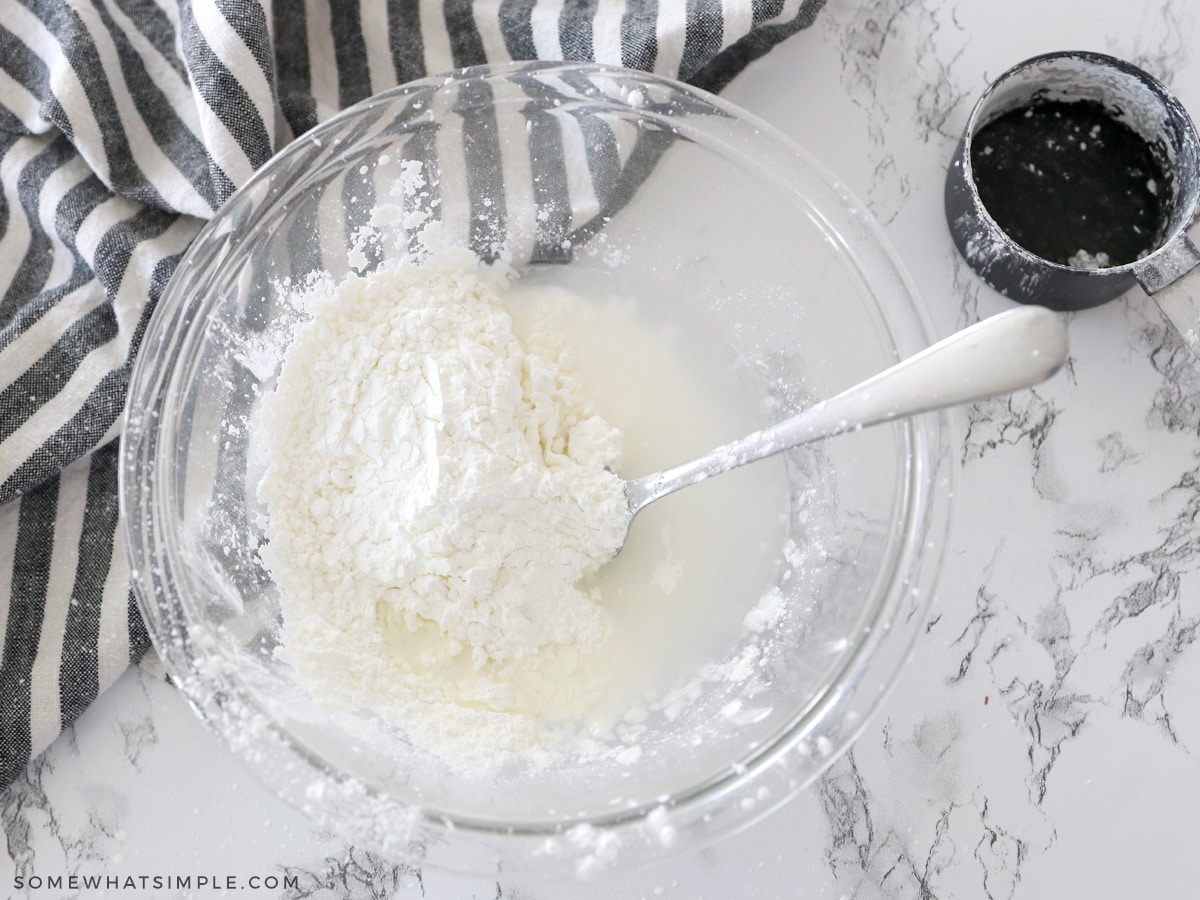
Oobleck Recipe
DIRECTIONS – Mix the cornstarch with water in your bowl. Add more or less of each ingredient until you get the consistency of honey.
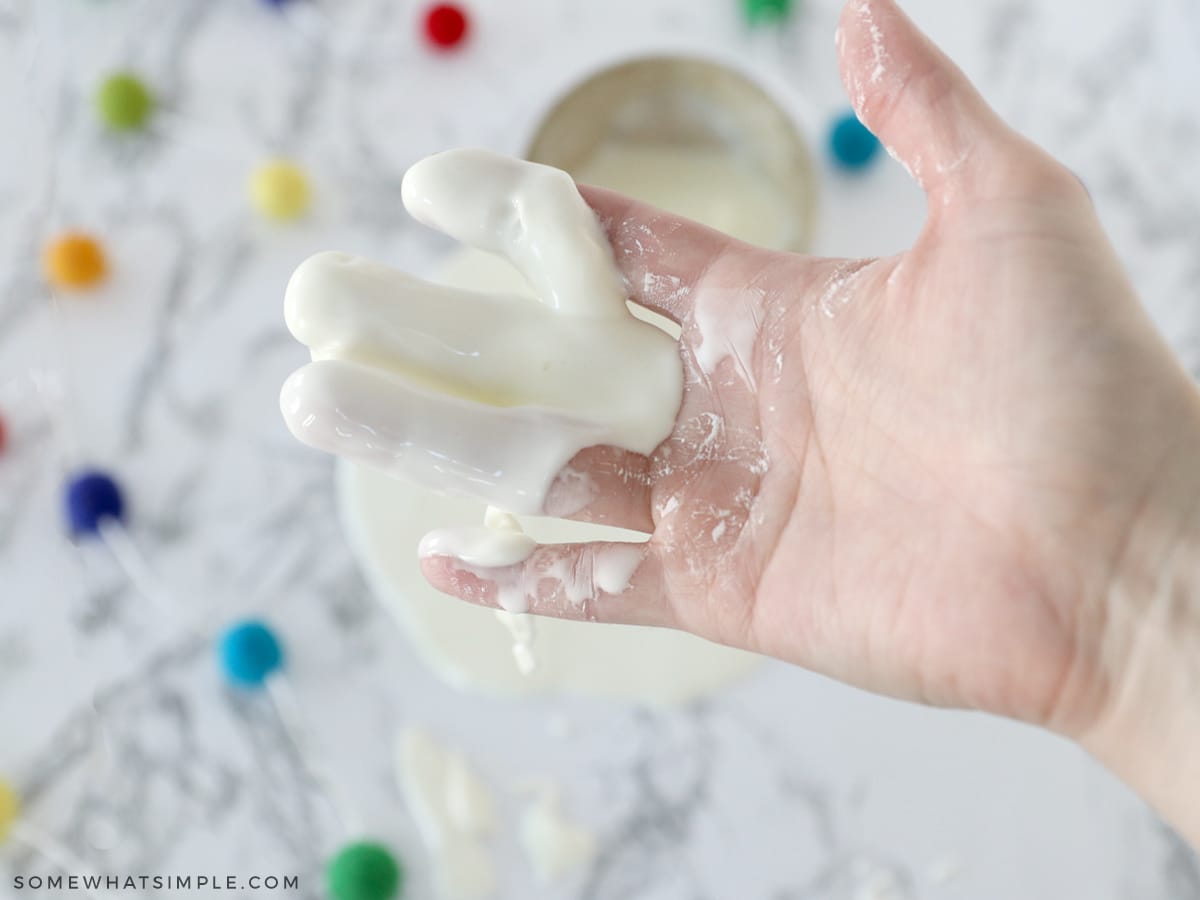
Play with it!
- Tap the surface with a spoon- does it splash?
- Grab a handful and watch it slip through your fingers.
- Grab another handful and squeeze it in your palms. Does it slip through?
- Let your fingers slip slowly down to the bottom of the bowl. Try to pull them out fast!
- Grab a handful and roll it in the palm of your hands to make a ball. Stop rolling and watch what happens!
- Place a small plastic toy on the surface- does it sink?
- Stir the mixture slowly with your finger- do you feel resistance?
- Now, stir the mixture quickly with your finger – do you feel resistance now?
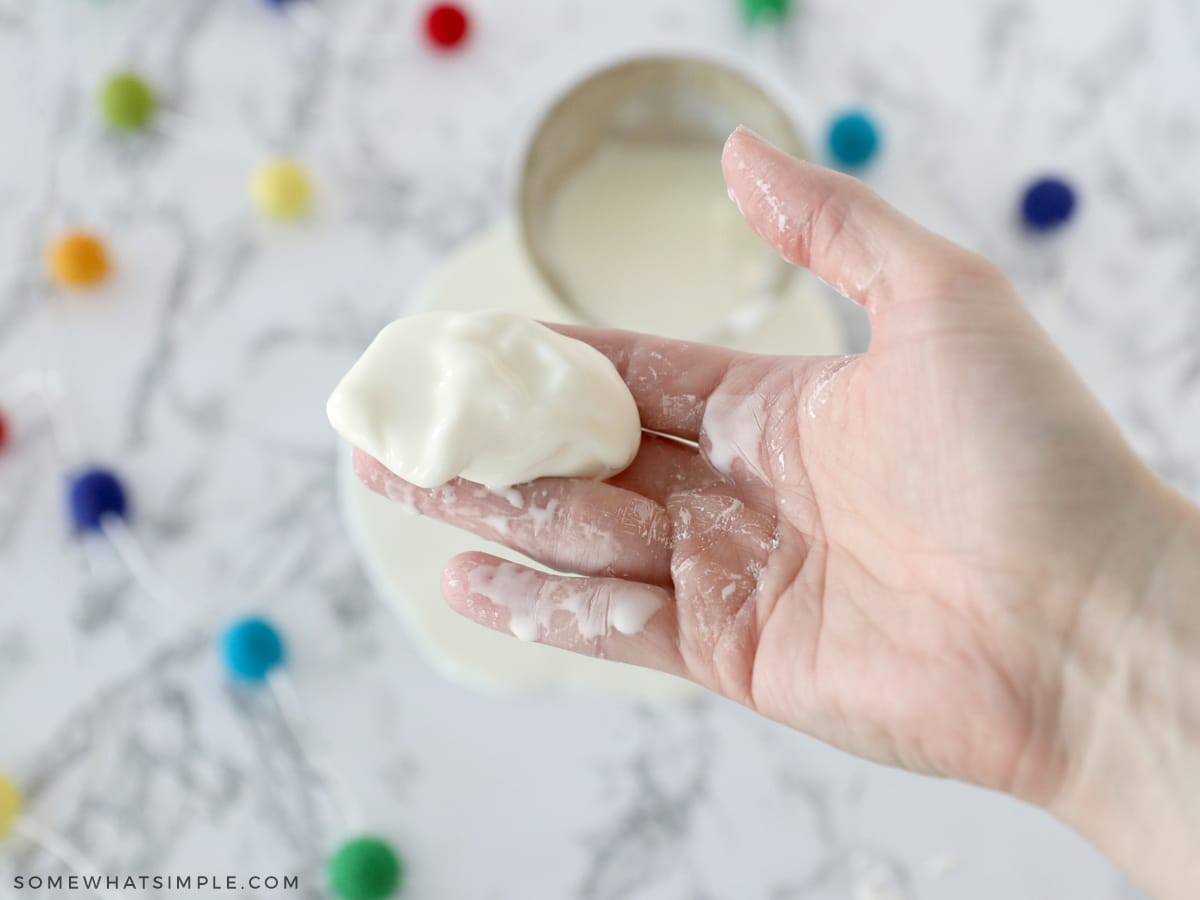
Cornstarch and Water Science Experiment Explanation
In the 1700s, Sir Isaac Newton identified the properties of a liquid. Water, juice, and other liquids have those properties and are called Newtonian Liquids or Fluids. The cornstarch and water mixture has properties of both a liquid and a solid, so it is identified as a non-Newtonian fluid.
This mixture is made up of solid particles suspended in water. Chemists, Physicists, and Scientists call this type of mixture a colloid . Colloids behave differently than solids and liquids. It can act like a solid when you apply force but acts like a liquid when it isn’t under pressure.
Can you name any other non-Newtonian fluids?
Ketchup and quicksand are both non-Newtonian fluids.
- Next time you need to get some stubborn ketchup out of a bottle, don’t smack it – that will actually slow it down. All you need to do to get it out is to tip it over and have some patience.
- And if you ever find yourself in quicksand, don’t panic and try to get out quickly! Move slowly, because the less force you apply, the less the quicksand will resist your movement.
Leave us a comment below if you try this cornstarch and water experiment and let us know how it goes. HAVE FUN EXPERIMENTING!!
Here is a video my kids and I made doing this cornstarch and water experiment, but keep reading for detailed directions and scientific applications –
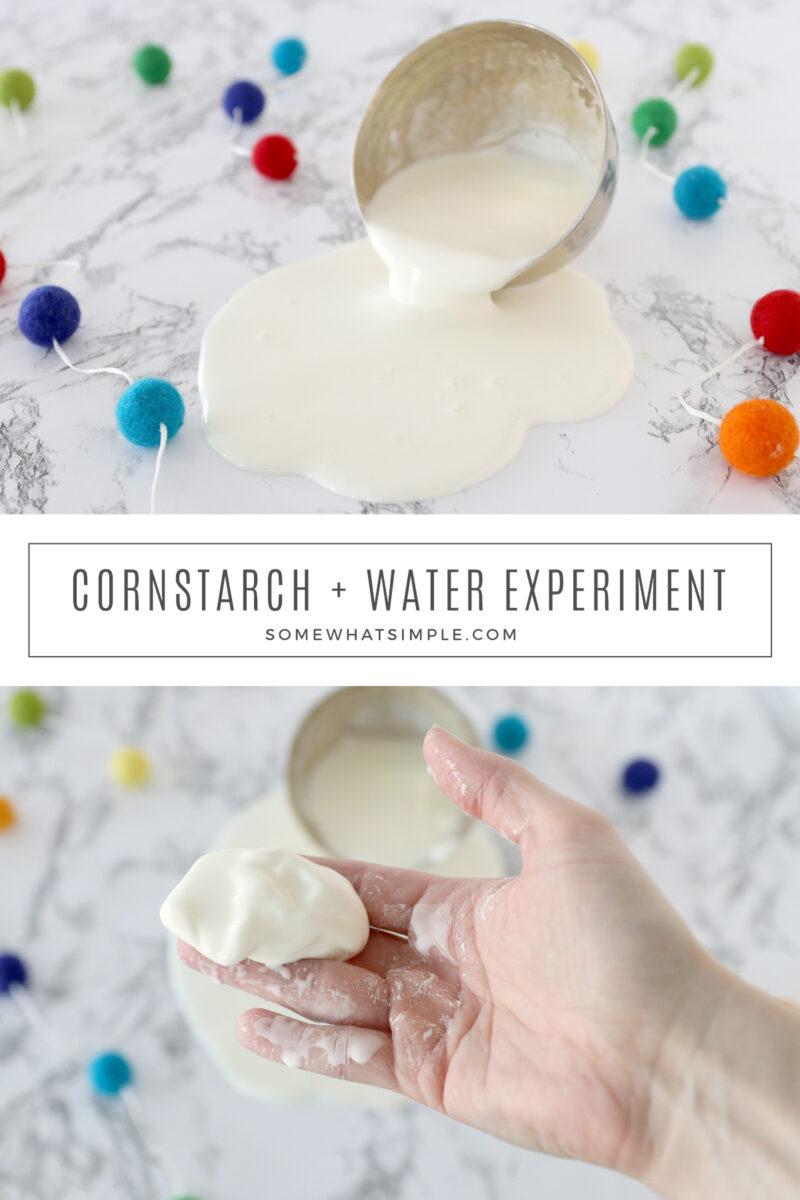
Busy moms, this one is for YOU!
Leave a review cancel reply.
I love hearing from you! Submit your question or review below. Your email address will not be published. Required fields are marked*.
Notify me via e-mail if anyone answers my comment.
I consent to Somewhat Simple collecting and storing the data I submit in this form. (Privacy Policy) *

What are you looking for?
Get on the list.
By clicking GO, you're consenting to be added to our newsletter list. Don't worry, we won't ever send you spam and you can unsubscribe at any time.
- PRO Courses Guides New Tech Help Pro Expert Videos About wikiHow Pro Upgrade Sign In
- EDIT Edit this Article
- EXPLORE Tech Help Pro About Us Random Article Quizzes Request a New Article Community Dashboard This Or That Game Forums Popular Categories Arts and Entertainment Artwork Books Movies Computers and Electronics Computers Phone Skills Technology Hacks Health Men's Health Mental Health Women's Health Relationships Dating Love Relationship Issues Hobbies and Crafts Crafts Drawing Games Education & Communication Communication Skills Personal Development Studying Personal Care and Style Fashion Hair Care Personal Hygiene Youth Personal Care School Stuff Dating All Categories Arts and Entertainment Finance and Business Home and Garden Relationship Quizzes Cars & Other Vehicles Food and Entertaining Personal Care and Style Sports and Fitness Computers and Electronics Health Pets and Animals Travel Education & Communication Hobbies and Crafts Philosophy and Religion Work World Family Life Holidays and Traditions Relationships Youth
- Browse Articles
- Learn Something New
- Quizzes Hot
- Happiness Hub
- This Or That Game
- Train Your Brain
- Explore More
- Support wikiHow
- About wikiHow
- Log in / Sign up
- Hobbies and Crafts
- Craft for Kids
- Putty Dough and Slime
How to Make Oobleck
Last Updated: September 19, 2024 Fact Checked
This article was co-authored by wikiHow Staff . Our trained team of editors and researchers validate articles for accuracy and comprehensiveness. wikiHow's Content Management Team carefully monitors the work from our editorial staff to ensure that each article is backed by trusted research and meets our high quality standards. This article has been fact-checked, ensuring the accuracy of any cited facts and confirming the authority of its sources. This article has been viewed 1,766,737 times. Learn more...
Oobleck (also called magic mud ) is an easy-to-make substance that has some interesting physical properties. Oobleck is an example of a non-Newtonian fluid. Many common liquids like water and alcohol have a constant viscosity. But Oobleck can be liquid when held loosely in your hand, and can also act like a solid if it's hit more violently. The name comes from Dr. Seuss's 1949 children's book, Bartholomew and the Oobleck, which is about a king who is so bored with the weather in his kingdom that he wants something completely new to fall from the sky.
Making Oobleck

- Use as many drops as you want for a richer color.
- If you can't form a ball (too watery), add more cornstarch in one tablespoon at a time. Mix it and test each time.
- If it isn't runny like a liquid when picked up, it is too thick. Add more water one tablespoon at a time.
Using Your Oobleck
- Mix and match with other colors to make designs.
- Strain and drop the oobleck through strainers, strawberry crates, etc. to watch how it flows differently than water.
- Make a ball out of the Oobleck by rolling it around quickly in your palms. Then, stop applying pressure to the mixture and it will flow out of your hands.
- Fill a pie plate with a thick layer of Oobleck and slap the surface with your open hand. You'll be surprised by how all of the liquid stays on the plate because of the force you applied.
- Supersize the pie plate experiment by filling a large bucket or plastic bin with Oobleck and jumping up and down in it.
- Take the Oobleck in the freezer, and try it. Try it in the heat too. Is there a difference?
- If you let it dry out, it turns into a powder that is easily swept, vacuumed, or wiped up.

- You'll likely need to re-add water to your oobleck to play with it a second time.
Community Q&A

- If you don’t have cornstarch you can use shampoo, body wash, or even laundry detergent. Thanks Helpful 48 Not Helpful 17
- Oobleck when dried can be easily vacuumed. Thanks Helpful 35 Not Helpful 15
- If you put in food coloring: after washing your hands, you may notice a little bit of color left on your hands. Don't worry. It should go away in a day or two. Thanks Helpful 29 Not Helpful 12
Tips from our Readers
- It's sometimes hard to get off a counter with deep grooves, so definitely make and play with it on a smooth surface.
- Just make sure to rinse the bowl out with a lot of hot water because if you don't, your drain may get clogged.
- If you don't have cornstarch or baby powder, use potato starch. It works great!

- Do not pour the Oobleck down the drain or else the drain may become clogged. Thanks Helpful 35 Not Helpful 8
- Oobleck isn't poisonous, but it tastes awful. Wash your hands after playing. Make sure children are supervised. Thanks Helpful 36 Not Helpful 9
- Be aware that if Oobleck is left out too long, it will dry out and turn back to cornstarch. Just throw it away when you're done with it. Thanks Helpful 30 Not Helpful 9
- Lay a couple newspapers on the floor so it doesn't get all over the floor or table. Thanks Helpful 28 Not Helpful 9
- When you add the cornstarch, be sure to spread it out evenly. Thanks Helpful 28 Not Helpful 11
- Don't use plastic spoons to mix the ingredients. It might break if there is too much pressure. Thanks Helpful 30 Not Helpful 13
- Don't worry too much if it gets on something; it will come out with a little water. Thanks Helpful 29 Not Helpful 13
- Make sure the container has no air in it so that it won't dry out. Thanks Helpful 25 Not Helpful 11
- Don't drop on the couch, deck, or sidewalk. It's hard to get off of certain surfaces. Thanks Helpful 23 Not Helpful 12
- Wear old clothes, as Oobleck tends to get messy. Thanks Helpful 28 Not Helpful 17
- Don't let it just sit there for a while. Thanks Helpful 22 Not Helpful 13
Things You'll Need
- Cornstarch (sometimes called 'cornflour')
- Food coloring (optional)
- Air-tight container (for storage)
- Glitter (optional)
You Might Also Like

- ↑ https://www.pbs.org/parents/crafts-and-experiments/how-to-make-oobleck
- ↑ https://www.bbcgoodfood.com/howto/guide/oobleck
- ↑ https://sciencenotes.org/how-to-make-oobleck/

About This Article

To make Oobleck, mix 2 parts cornstarch and 1 part water in a bowl. Add in a few drops of food coloring if you want. Continue to mix the Oobleck until you are able to form a ball by rolling the mixture quickly in your hands. If the Oobleck is too runny to form a ball, add in more cornstarch a little at a time. If the mixture is too dry to stick together, add in a little more water. Once you get the right consistency, knead, roll, and stretch the Oobleck to see how it reacts. If you want to learn more about how to store your Oobleck to play with it later, keep reading! Did this summary help you? Yes No
- Send fan mail to authors
Reader Success Stories
LynnDell Watson
Mar 22, 2017
Did this article help you?

Hannah Spooler
Mar 16, 2018
Apr 12, 2017
Gabrielle Inoc
Sep 26, 2018
May 18, 2016

Featured Articles

Trending Articles

Watch Articles

- Terms of Use
- Privacy Policy
- Do Not Sell or Share My Info
- Not Selling Info
wikiHow Tech Help Pro:
Level up your tech skills and stay ahead of the curve
Oobleck: the Dr. Seuss Science Experiment

Introduction: Oobleck: the Dr. Seuss Science Experiment
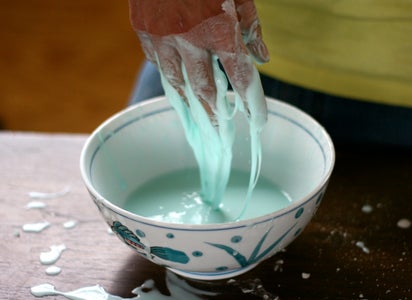
Step 1: Materials

Step 2: Mix It Up!
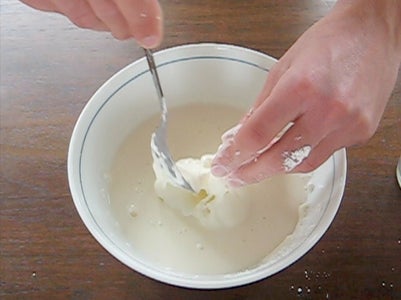
Step 3: Add Food Coloring
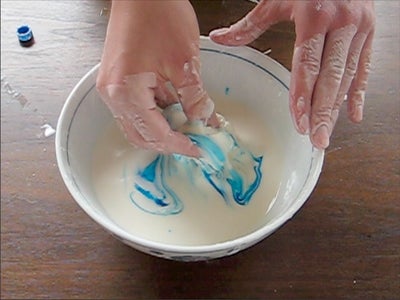
Step 4: Play With It!
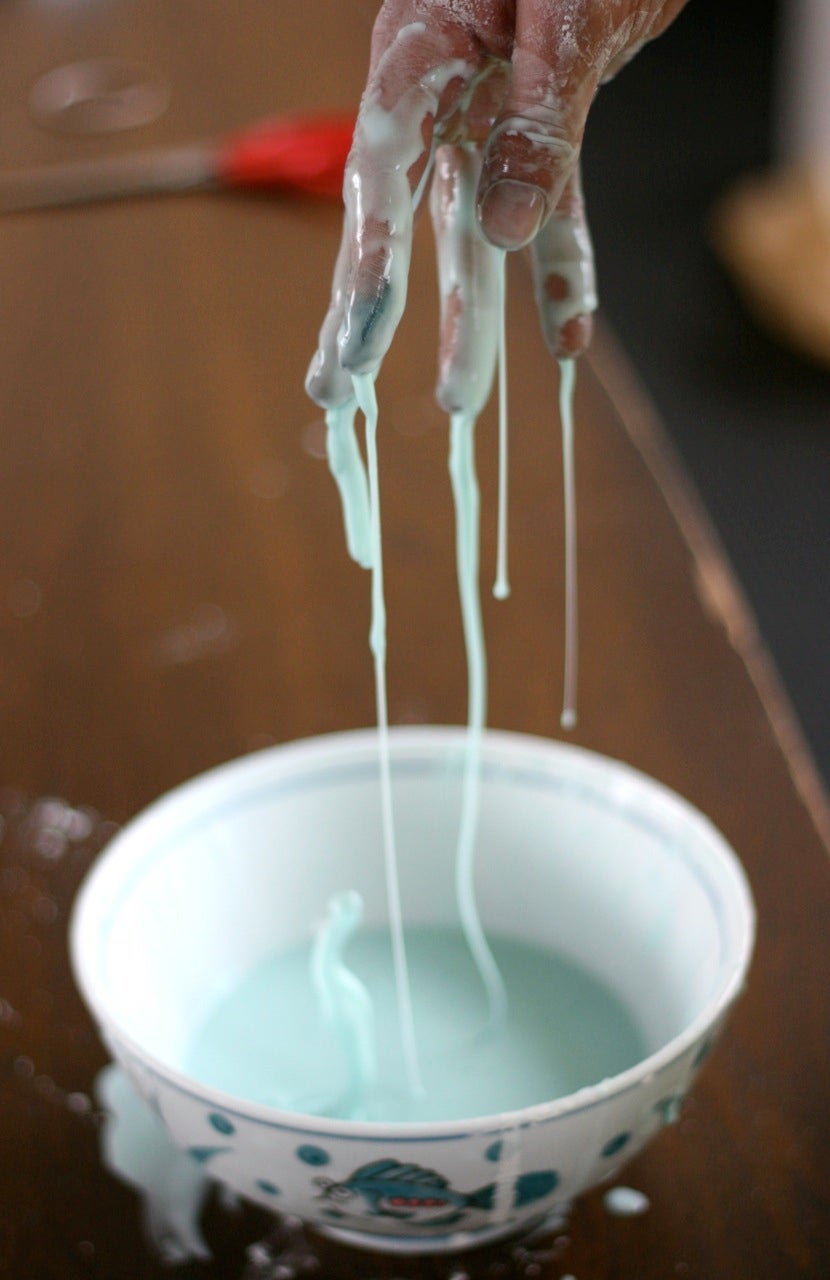
Step 5: Oobleck Videos
Still not convinced you want to make it? Play this video to see it in action.
How to Make Oobleck
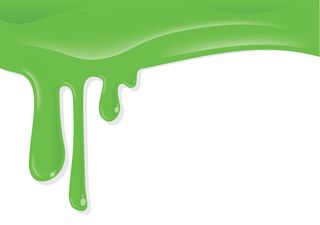
Want to have fun with physics and even "walk on water"? Try making a mixture of cornstarch and water called oobleck. It makes a great science project or is just fun to play with.
Oobleck is a non-Newtonian fluid; it has properties of both liquids and solids. You can slowly dip your hand into it like a liquid, but if you squeeze the oobleck or punch it, it will feel solid. The name oobleck comes from the Dr. Seuss book, “Bartholomew and the Oobleck.” In the story, oobleck, a gooey green substance, fell from the sky and wreaked havoc in the kingdom.
Making oobleck is easy. Here's a recipe:
Oobleck ingredients
- 1 part water
- 1.5 to 2 parts cornstarch
- Small amount of food coloring (optional)
Mix ingredients
- Start with the water in a bowl (or wading pool!) and add the cornstarch a bit at a time.
- Keep stirring until it has a gooey consistency. You may want to use your hands.
- When the oobleck is just right, slowly add food coloring, if you want. This can be a challenge to get it mixed properly.
- Play with it.
Things to do with oobleck
- Grab a handful and squeeze it. Let it ooze through your fingers.
- Make a puddle and quickly drag your fingers through it.
- Put it into a plastic container and shake it or quickly bump it against a table.
- Jab at the oobleck and then slowly let your finger sink in.
- Roll some oobleck into a ball. It becomes solid, but when you stop moving it, it will melt back into your hand.
Some science projects use oobleck. Experiments you can try include:
Put some oobleck on an old speaker and watch it dance:
Or, put it in a cookie sheet on top of a speaker:
Put a lot of it in a kiddie pool and walk across it:
- Store in an air-tight container. Mix occasionally.
- If you put in food coloring, you may notice a little bit of color left on your hands after washing. Don't worry. It should go away in a day or two.
- Anything put into the slime can be washed with soap and water.
- To dispose of the oobleck, mix it with a lot of hot water to make a very loose slurry. Pour a small amount into the drain while the hot water is running.
- Oobleck when dried can be easily vacuumed.
- Don't drop oobleck on a couch, deck, or sidewalk. It's hard to get off.
- Oobleck isn't poisonous, but it tastes awful. Wash your hands after playing. Make sure children are supervised.
- Wear old clothes, as oobleck tends to get messy.
- Don't worry too much if it gets on something; it will come out with a little water.
- Lay a couple newspapers on the floor so it doesn't get all over the floor or table.
- Oobleck may solidify if it's not kept wet. If it hardens, just throw it away.
- If oobleck is left out too long, it will dry out and turn back to cornstarch.
Related: Oobleck's Weird Properties Demystified
Sign up for the Live Science daily newsletter now
Get the world’s most fascinating discoveries delivered straight to your inbox.
Tim Sharp was Live Science’s reference editor from 2012 to 2018. Tim received a degree in Journalism from the University of Kansas. He worked for a number of other publications, including The New York Times, Des Moines Register and Tampa Bay Times, and as an editor for the Hazelden Foundation, among others.
24 brain networks kick in when you watch movies, study finds
Content funding on Live Science
Indian Ocean gravity hole: The dent in Earth's gravitational field created by the death of an ancient ocean
Most Popular
- 2 World's 1st silicon anode EV battery will let you drive up to 186 miles after just 5 minutes of charging
- 3 'Impossible' black holes discovered by the James Webb telescope may finally have an explanation
- 4 Octopuses burn more calories changing color than you use on a 25-minute run
- 5 US volcanoes quiz: How many can you name in 10 minutes?

IMAGES
VIDEO
COMMENTS
Oobleck - The Cornstarch And Water Experiment. This may just be the easiest, messiest, and most fun science activity I know. It is a classic, and I have gotten several requests recently to post directions. You should know that if you try this activity and you are not smiling and messy with corn starch goo at the end, then you are definitely ...
The cornstarch-and-water mixture creates a fluid that acts more like quicksand than water: applying force (squeezing or tapping it) causes it to become thicker. If you were trapped in a tub of ...
Cornstarch and Water Science Experiment Explanation. In the 1700s, Sir Isaac Newton identified the properties of a liquid. Water, juice, and other liquids have those properties and are called Newtonian Liquids or Fluids. The cornstarch and water mixture has properties of both a liquid and a solid, so it is identified as a non-Newtonian fluid.
1. Add 2 cups cornstarch and 1 cup water to a mixing bowl or container. If you want to make more goop for multiple kids, you can simply increase the amount of the two ingredients. However, make sure that you always maintain the same cornstarch to water ratio. 2. Mix thoroughly until the cornstarch and water until your oobleck is formed. 3.
In the cornstarch-water mixture individual tiny particles of cornstarch are suspended throughout the water. The cornstarch pieces are very tiny, with an average size of 1500 nanometers in diameter. (A nanometer is very small — a human hair is about 100,000 nanometers wide!) In Oobleck, the cornstarch pieces are evenly spread throughout the water.
At times, it may seem like a solid or a liquid but it acts differently than a normal solid or liquid. Making oobleck is a great science experiment to show how changes in pressure can change the properties of some materials. Sort of like how temperature changes the properties of water. Cold or freezing temperatures turns water into ice.
To make Oobleck, mix 2 parts cornstarch and 1 part water in a bowl. Add in a few drops of food coloring if you want. Continue to mix the Oobleck until you are able to form a ball by rolling the mixture quickly in your hands. If the Oobleck is too runny to form a ball, add in more cornstarch a little at a time.
Learn how to make oobleck with this simple recipe of cornstarch and water! Oobleck is SO FUN to play with and it's a great science experiment for kids involving non-Newtonian fluids and viscosity. Oobleck Recipe Have you ever heard of oobleck?! This substance gets its name from a Dr. Seuss book, Bartholomew and the Oobleck. In the book, Bartholomew has to rescue his kingdom from a sticky green ...
Oobleck: the Dr. Seuss Science Experiment: Oobleck is a classic science experiment that's perfect for entertaining both kids and adults. ... All you need is corn starch and food coloring and the food coloring is optional. Recipe: - 1 cup water - 1.5-2 cups corn starch - a few drops of food coloring of your choice Step 2: Mix It Up!
Try making a mixture of cornstarch and water called oobleck. It makes a great science project or is just fun to play with. Oobleck is a non-Newtonian fluid; it has properties of both liquids and ...